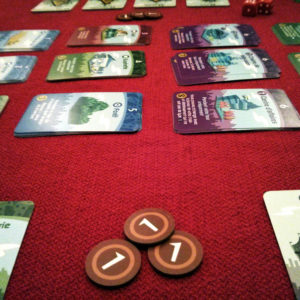Throw SimCity out the window and grab a fistful of dice. It’s time to play Machi Koro, the dice-building game for 2-4 players that’s captured the attention of thousands of board gamers. In fact, it was nominated for Spiel des Jahres in 2015 – a huge honor. In the game, you gradually build up the beautiful city of Machi Koro, starting with nothing more than a single die and the desire to create some urban sprawl. The first person to build the four landmarks – Train Station, Shopping Mall, Amusement Park, and Radio Tower – is the winner.

Looking for more resources to help you on your board game design journey?
Here you go: no email required!
Like this writing style?
Check out my latest blog on marketing here.
As any good city mayor does, you understand the importance of political expediency that comes from building flashy landmarks. Yet you’re held back by a banal reality: money. It’s all about that dosh. To help you accumulate that sweet, sweet dough, there’s four types of cards that you can buy.
- Blue cards (Primary Industry) – they earn you money from the bank during anyone’s turn
- Green cards (Secondary Industry) – they earn you money from the bank during your turn only
- Red cards (Restaurants) – they earn you money from the player who rolled the dice
- Purple cards (Major Establishments) – they earn you money from all other players during your turn only
All of these cards are only activated when the dice roll the number at the top of the card. This is what I want to talk about, because it is this mix of probability and strategy that drives Machi Koro.
Players must think about the benefits of duplicates of one card vs. singles of many cards.
Without even going into a detailed analysis of which cards a player may find more attractive, one of the most immediately striking rules in the game is as follows. Getting more duplicates of a card cause the effects of the card to accumulate. The humble Wheat Field nets you one coin every time anybody rolls a 1. However, if you have five of them, suddenly you’ve got five coins at once. How’s that for a bonus check?
This raises a question: is it better to get a whole bunch of different cards OR just duplicates of the same card? The former could leave you with a steady sum of small payments whereas the latter could leave you with a very inconsistent series of massive payments.
This game may be fairly lightweight, and yes – I’ll admit – maybe a bit too luck-based for some folks’ tastes, but the question I raised above kicks off a chain of calculations in the players’ heads. Using the probability of a dice roll of X during your turn/your opponent’s turn assigns a dollar value to each card based on what you expect to happen. In fact, the Machi Koro Wikia gives each card an expected value. You can manipulate the expected value of the money you’ll receive in a turn in the way you choose your cards. This is by no means a heavy game, but it’s pinned to some surprisingly deep questions of value and probability. It’s the sort of stuff you see in economics and finance. But the player doesn’t have to think about this. They just feel it. It’s intuitive.
Players have to think about the benefits of growth vs. theft.
Choosing cards and choosing the quantity of cards is a matter of tactics. Deciding whether you prefer to gain money through organic growth or theft is a matter of strategy. Blue and Green cards earn you money from the bank. Red and Purple cards earn you money from other players.
In a general sense, Blues and Greens will end the game faster since more money gives everybody a better shot at buying landmarks. Reds and Purples redistribute money within the Machi Koro economy, which postpones the end of the game, giving you a slight edge you didn’t have before.
Suffice it to say, if you’re winning, you probably want Blues and Greens padding your wallet with that Machi Dinero. If you’re losing, you probably want Reds and Purples to cut the fatcat capitalists above you down to your size.
Machi Koro is lightweight, simple, pretty, and more strategic than people often give it credit for! Right now it’s $19.29 on Amazon with free shipping. I suggest you check it out if you haven’t already!






2 thoughts on “Machi Koro: Making Players Think about Chance”
As infantes têm bastante contato com a água. https://dmlnews.com/report-3-groups-europeans-attempt-sneak-us-canada/